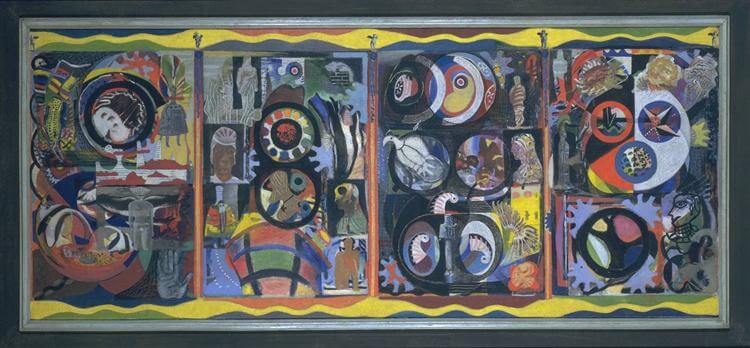Title of Artwork: “The Autobiography of an Embryo”

Artwork by Eileen Agar
Year Created 1933 – 1934
Summary of The Autobiography of an Embryo
Between 1933 and 1934, Agar lived at 47 Bramham Gardens in Earls Court, London, and painted this intricate and colourful composition. She was aware of the ideas advanced by the Surrealist movement, despite not being a member of it. Her eccentric juxtaposition of ideas and images, first seen in Three Symbols, was expanded upon in The Autobiography of an Embryo.
All About The Autobiography of an Embryo by Eileen Agar
The horizontal painting is divided into four sections by an ornamental border that runs along the top and bottom. The composition has a classical wall painting feel thanks to the winged putti perched atop the dividing columns. The abstract patterns and shapes are also influenced by Greco-Roman art. Draped figures that resemble old statues, as well as geometric patterns that resemble Greek pottery decoration.
A wide range of symbols evoke cultural heritage. In the second section, a profiled head and the head of an African woman both allude to Italian Renaissance portraiture. The squat figure, which appears twice in the first two sections, is a representation of Ubu from Alfred Jarry’s 1896 French play. These quotations are combined with modern elements such as the brick wall in the second section and the graffitti-like head on the far right.
The composition contains numerous biological and organic elements. Agar may have been inspired by Franticek Foltyn, a Czech painter who taught Agar in Paris and used similar themes in his work. Plant-like structures coexist with shell- and wing-like forms, while circular shapes allude to fossils, cells, or embryonic forms. Agar reportedly kept a fish tank in the 1930s and was fascinated by the aquariums at London and Naples zoos. She frequented the Jardin des Plantes in Paris, where she became fascinated by “the bones of that protobird, the Archaeopteryx,” according to her autobiography (pp. 84-5).
This could be related to the winged structure of the third segment. “I was enthralled by fossils,” she continued, “their subdued colour and embedded beauty.” They arrive as isolated events in time that take on the significance of an issue fixed at a time long before the haze of human memory. “I discovered the mysteries of animal structure, and from there, naturally, the issue of human structure came to me” (quoted in Illustrated Catalogue of Acquisitions 1986-88, p.240). The discovery by Agar that “human foetuses have gills for about 12 weeks because in the evolution of our species we went through an amphibian stage” (quoted in Illustrated Catalogue of Acquisitions 1986-88, p.240) helped to clarify this connection. Written by Chloe Johnson
Information citations:
https://www.wikiart.org/en/eileen-agar/the-autobiography-of-an-embryo-1934
























